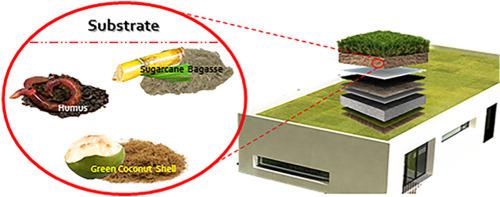Sustainable Chemistry and Pharmacy ( IF 6 ) Pub Date : 2021-06-24 , DOI: 10.1016/j.scp.2021.100477 Milla Araújo de Almeida , Renata Colombo

|
The present paper reports the development of nutritious substrates through the use of renewable materials via vermicomposting. Vermicomposting was carried out using stacked bin composter (14.5 cm high, 78 cm wide and 30 cm long) filled with sawdust/soil mixture, fresh wastes, Eisenia fetida and dry wastes; this led to the generation of humus with chemical composition suitable for use as nutritional component (41.9% moisture; pH 7.3; 31.2% organic matter; 17.5 and 3.2% of fulvic and humic acid, respectively; NPK ratio ~1:1:1). Six different substrates were constructed using the humus generated from vermicomposting and sugarcane bagasse or green coconut fiber. The physical stability and nutritional capacity of these substrates, as well as their application feasibility as substrates for green roofs were evaluated using green roof prototypes. The green roof prototypes were exposed to natural environment with an inclination angle of 45°. The physico-chemical analysis conducted showed that the substrates exhibited suitable field capacity (17–37%), good nutritional properties (0.09–0.46 gkg−1 nitrogen; 92.9–494.6 mgdm−3 phosphorus and 7.0–37.0 mmolcdm−3 potassium) and pH (5.4–7.2) that are ideal for plant nutrition. Comparing the substrates produced from green coconut fiber with those from sugarcane bagasse, it was found that some of those produced from sugarcane bagasse had nitrogen content closer to the range reported as ideal. The density (0.79–1.6 gcm−3) and physical stability of the substrates make them suitable for application as substrates in green roofs, but those from green coconut fiber have relatively lower field capacity, being considered the most suitable for this application.
中文翻译:

使用腐殖质和绿色椰子纤维或甘蔗渣制成的基材建造绿色屋顶
本论文报告了通过蚯蚓堆肥使用可再生材料来开发营养基质。蚯蚓堆肥使用堆满木屑/土壤混合物、新鲜废物、Eisenia fetida 的堆肥箱(14.5 cm 高、78 cm 宽、30 cm 长)进行和干垃圾;这导致产生具有适合用作营养成分的化学成分的腐殖质(41.9% 水分;pH 7.3;31.2% 有机物;分别为 17.5% 和 3.2% 的富里酸和腐殖酸;NPK 比率 ~1:1:1) . 使用从蚯蚓堆肥和甘蔗渣或绿色椰子纤维中产生的腐殖质构建了六种不同的基质。使用绿色屋顶原型评估了这些基材的物理稳定性和营养能力,以及它们作为绿色屋顶基材的应用可行性。绿色屋顶原型暴露在自然环境中,倾角为 45°。进行的理化分析表明,基质表现出合适的田间容量(17-37%)、良好的营养特性(0.09-0.46 gkg - 1氮; 92.9–494.6 mgdm -3磷和 7.0–37.0 mmolcdm -3钾)和 pH (5.4–7.2) 是植物营养的理想选择。比较由绿色椰子纤维生产的基质与甘蔗渣生产的基质,发现一些由甘蔗渣生产的基质的氮含量接近报告的理想范围。基材的密度 (0.79–1.6 gcm -3 ) 和物理稳定性使其适合用作绿色屋顶的基材,但来自绿色椰子纤维的那些具有相对较低的场容量,被认为最适合这种应用。



























 京公网安备 11010802027423号
京公网安备 11010802027423号